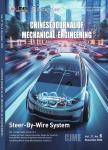Optimal Design and Force Control of a Nine-Cable-Driven Parallel Mechanism for Lunar Takeoff Simulation
Optimal Design and Force Control of a Nine-Cable-Driven Parallel Mechanism for Lunar Takeoff Simulation作者机构:Department of Mechanical Engineering Tsinghua University Beijing 100084China Beijing Institute of Spacecraft EnvironMent Engineering China Academy of Space Technology Beijing 100094 China Beijing Engineering Research Center of the Intelligent AsseMbly Technology and EquipMent for Aerospace Product Beijing Institute of Spacecraft EnvironMent Engineering Beijing 100094China School of Mechanical Engineering and AutoMation Beihang University Beijing 100191China Beijing Institute of Radio MeasureMent Second Research Institute of the China Aerospace Science and Industry Group Beijing 100854 China
出 版 物:《Chinese Journal of Mechanical Engineering》 (中国机械工程学报(英文版))
年 卷 期:2019年第32卷第4期
页 面:35-46页
核心收录:
基 金:Supported by National Natural Science Foundation of China(Grant No.51405024)
主 题:Force control Lunar takeo simulation Parallel robots Surrogate mathematical model
摘 要:Traditional simulation methods are unable to meet the requirements of lunar takeo simulations, such as high force output precision, low cost, and repeated use. Considering that cable-driven parallel mechanisms have the advantages of high payload to weight ratio, potentially large workspace, and high-speed motion, these mechanisms have the potential to be used for lunar takeo simulations. Thus, this paper presents a parallel mechanism driven by nine cables. The purpose of this study is to optimize the dimensions of the cable-driven parallel mechanism to meet dynamic workspace requirements under cable tension constraints. The dynamic workspace requirements are derived from the kinematical function requests of the lunar takeo simulation equipment. Experimental design and response surface methods are adopted for building the surrogate mathematical model linking the optimal variables and the optimization indices. A set of dimensional parameters are determined by analyzing the surrogate mathematical model. The volume of the dynamic workspace increased by 46% after optimization. Besides, a force control method is proposed for calculating output vector and sinusoidal forces. A force control loop is introduced into the traditional position control loop to adjust the cable force precisely, while controlling the cable length. The e ectiveness of the proposed control method is verified through experiments. A 5% vector output accuracy and 12 Hz undulation force output can be realized. This paper proposes a cable-driven parallel mechanism which can be used for lunar takeo simulation.




